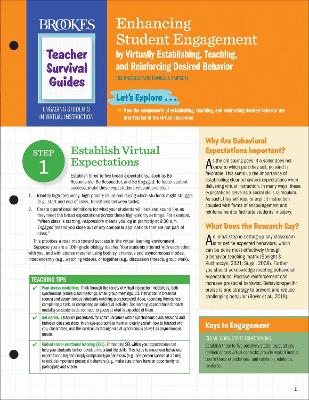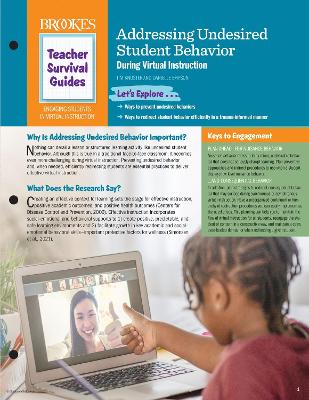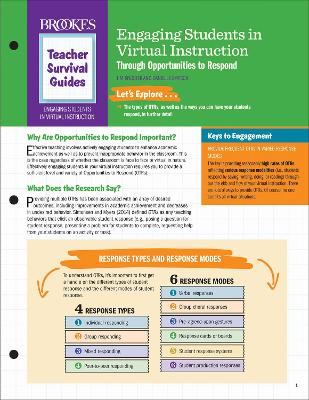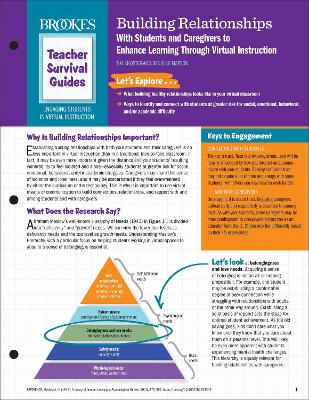Teacher Survival Guides
4 total works
Enrollment in virtual and blended schools is on the rise—introducing new challenges with student engagement, social–emotional wellness, and behavior management. Help is here with this laminated quick–guide, one of four concise Teacher Survival Guides on Engagement of Students in Virtual Instruction.
With tips and strategies from Tim Knoster and Danielle Empson, this guide demystifies one key to success in virtual learning environments: promoting positive behavior. Teachers will learn about the interrelated components of establishing, teaching, and reinforcing desired behavior in an online classroom. They'll also get clear, actionable guidance on delivering explicit instruction and reinforcement to help students meet behavioral expectations in a trauma-informed manner.
GET THE COMPLETE SERIES: The four Teacher Survival Guides on Engagement of Students in Virtual Instruction are filled with the ready–to–use guidance K–12 teachers need to boost engagement, student wellbeing, and positive behavior in virtual settings. Packed with bite–sized nuggets of insight—including keys to engagement, teaching tips, proven strategies, and FAQs—these laminated, six–panel guides will help any teacher take immediate action to support their students academic, social–emotional, and behavioral success. Learn more about the other quick-guides in the series:
Building Relationships With Students and Caregivers to Enhance Learning Through Virtual Instruction
Engaging Students in Virtual Instruction Through Opportunities to Respond
Addressing Undesired Student Behavior During Virtual Instruction
With tips and strategies from Tim Knoster and Danielle Empson, this guide demystifies one key to success in virtual learning environments: promoting positive behavior. Teachers will learn about the interrelated components of establishing, teaching, and reinforcing desired behavior in an online classroom. They'll also get clear, actionable guidance on delivering explicit instruction and reinforcement to help students meet behavioral expectations in a trauma-informed manner.
GET THE COMPLETE SERIES: The four Teacher Survival Guides on Engagement of Students in Virtual Instruction are filled with the ready–to–use guidance K–12 teachers need to boost engagement, student wellbeing, and positive behavior in virtual settings. Packed with bite–sized nuggets of insight—including keys to engagement, teaching tips, proven strategies, and FAQs—these laminated, six–panel guides will help any teacher take immediate action to support their students academic, social–emotional, and behavioral success. Learn more about the other quick-guides in the series:
Building Relationships With Students and Caregivers to Enhance Learning Through Virtual Instruction
Engaging Students in Virtual Instruction Through Opportunities to Respond
Addressing Undesired Student Behavior During Virtual Instruction
Addressing Undesired Student Behavior During Virtual Instruction
by Timothy Knoster and Danielle Empson
Published 30 May 2022
Enrollment in virtual and blended schools is on the rise—introducing new challenges with student engagement, social–emotional wellness, and behavior management. Help is here with this laminated quick–guide, one of four concise Teacher Survival Guides on Engagement of Students in Virtual Instruction.
This how–to guide walks educators through four essential strategies for preventing and addressing undesired behavior, keys to success that can be especially challenging in online learning environments. Tim Knoster and Danielle Empson give teachers clear, research–based guidance on preventing undesired student behaviors before they start. Teachers will also learn how to efficiently redirect undesired student behavior—both nuisance-level and more consequential behavior—in a trauma–informed manner.
GET THE COMPLETE SERIES: The four Teacher Survival Guides on Engagement of Students in Virtual Instruction are filled with the ready–to–use guidance K–12 teachers need to boost engagement, student wellbeing, and positive behavior in virtual settings. Packed with bite–sized nuggets of insight—including keys to engagement, teaching tips, proven strategies, and FAQs—these laminated, six–panel guides will help any teacher take immediate action to support their students’ academic, social–emotional, and behavioral success. Learn more about the other quick-guides in the series:
Enhancing Student Engagement by Virtually Establishing, Teaching, and Reinforcing Desired Behavior
Engaging Students in Virtual Instruction Through Opportunities to Respond
Building Relationships With Students and Caregivers to Enhance Learning Through Virtual Instruction
This how–to guide walks educators through four essential strategies for preventing and addressing undesired behavior, keys to success that can be especially challenging in online learning environments. Tim Knoster and Danielle Empson give teachers clear, research–based guidance on preventing undesired student behaviors before they start. Teachers will also learn how to efficiently redirect undesired student behavior—both nuisance-level and more consequential behavior—in a trauma–informed manner.
GET THE COMPLETE SERIES: The four Teacher Survival Guides on Engagement of Students in Virtual Instruction are filled with the ready–to–use guidance K–12 teachers need to boost engagement, student wellbeing, and positive behavior in virtual settings. Packed with bite–sized nuggets of insight—including keys to engagement, teaching tips, proven strategies, and FAQs—these laminated, six–panel guides will help any teacher take immediate action to support their students’ academic, social–emotional, and behavioral success. Learn more about the other quick-guides in the series:
Enhancing Student Engagement by Virtually Establishing, Teaching, and Reinforcing Desired Behavior
Engaging Students in Virtual Instruction Through Opportunities to Respond
Building Relationships With Students and Caregivers to Enhance Learning Through Virtual Instruction
Engaging Students in Virtual Instruction through Opportunities to Respond
by Timothy Knoster and Danielle Empson
Published 30 May 2022
Enrollment in virtual and blended schools is on the rise—introducing new challenges with student engagement, social–emotional wellness, and behavior management. Help is here with this laminated quick–guide, one of four concise Teacher Survival Guides on Engagement of Students in Virtual Instruction.
Brimming with practical, research–based tips and strategies, this guide unlocks one of the keys to success in online learning environments: active engagement of all students. Teachers will discover how to engage students in virtual instruction by offering a wider variety of Opportunities to Respond (OTRs), a strategy that's been associated with improved academic achievement, student empowerment, and less undesired behavior. Tim Knoster and Danielle Empson introduce the benefits of providing multiple OTRs, the different types and modes for student responses, and how to monitor student engagement virtually.
GET THE COMPLETE SERIES: The four Teacher Survival Guides on Engagement of Students in Virtual Instruction are filled with the ready–to–use guidance K–12 teachers need to boost engagement, student wellbeing, and positive behavior in virtual settings. Packed with bite–sized nuggets of insight—including keys to engagement, teaching tips, proven strategies, and FAQs—these laminated, six–panel guides will help any teacher take immediate action to support their students academic, social–emotional, and behavioral success. Learn more about the other quick-guides in the series:
Building Relationships With Students and Caregivers to Enhance Learning Through Virtual Instruction
Engaging Students in Virtual Instruction Through Opportunities to Respond
Addressing Undesired Student Behavior During Virtual Instruction
Brimming with practical, research–based tips and strategies, this guide unlocks one of the keys to success in online learning environments: active engagement of all students. Teachers will discover how to engage students in virtual instruction by offering a wider variety of Opportunities to Respond (OTRs), a strategy that's been associated with improved academic achievement, student empowerment, and less undesired behavior. Tim Knoster and Danielle Empson introduce the benefits of providing multiple OTRs, the different types and modes for student responses, and how to monitor student engagement virtually.
GET THE COMPLETE SERIES: The four Teacher Survival Guides on Engagement of Students in Virtual Instruction are filled with the ready–to–use guidance K–12 teachers need to boost engagement, student wellbeing, and positive behavior in virtual settings. Packed with bite–sized nuggets of insight—including keys to engagement, teaching tips, proven strategies, and FAQs—these laminated, six–panel guides will help any teacher take immediate action to support their students academic, social–emotional, and behavioral success. Learn more about the other quick-guides in the series:
Building Relationships With Students and Caregivers to Enhance Learning Through Virtual Instruction
Engaging Students in Virtual Instruction Through Opportunities to Respond
Addressing Undesired Student Behavior During Virtual Instruction
Enrollment in virtual and blended schools is on the rise—introducing new challenges with student engagement, social–emotional wellness, and behavior management. Help is here with this laminated quick–guide, one of four concise Teacher Survival Guides on Engagement of Students in Virtual Instruction.
Designed to help teachers meet their students needs, this guide unlocks one of the keys to success in online learning environments: establishing trusting relationships. Tim Knoster and Danielle Empson show teachers how to create healthy relationships in a virtual classroom, build connections and rapport with both students and caregivers, and identify and connect with students at greater risk for social-emotional and/or academic difficulty. Teachers will gain useful insights from sample scenarios and student behavioral profiles, real–world teaching tips, and strategy adaptations for virtual classrooms.
GET THE COMPLETE SERIES: The four Teacher Survival Guides on Engagement of Students in Virtual Instruction are filled with the ready–to–use guidance K–12 teachers need to boost engagement, student wellbeing, and positive behavior in virtual settings. Packed with bite–sized nuggets of insight—including keys to engagement, teaching tips, proven strategies, and FAQs—these laminated, six–panel guides will help any teacher take immediate action to support their students academic, social–emotional, and behavioral success. Learn more about the other quick-guides in the series:
Enhancing Student Engagement by Virtually Establishing, Teaching, and Reinforcing Desired Behavior
Engaging Students in Virtual Instruction Through Opportunities to Respond
Addressing Undesired Student Behavior During Virtual Instruction
Designed to help teachers meet their students needs, this guide unlocks one of the keys to success in online learning environments: establishing trusting relationships. Tim Knoster and Danielle Empson show teachers how to create healthy relationships in a virtual classroom, build connections and rapport with both students and caregivers, and identify and connect with students at greater risk for social-emotional and/or academic difficulty. Teachers will gain useful insights from sample scenarios and student behavioral profiles, real–world teaching tips, and strategy adaptations for virtual classrooms.
GET THE COMPLETE SERIES: The four Teacher Survival Guides on Engagement of Students in Virtual Instruction are filled with the ready–to–use guidance K–12 teachers need to boost engagement, student wellbeing, and positive behavior in virtual settings. Packed with bite–sized nuggets of insight—including keys to engagement, teaching tips, proven strategies, and FAQs—these laminated, six–panel guides will help any teacher take immediate action to support their students academic, social–emotional, and behavioral success. Learn more about the other quick-guides in the series:
Enhancing Student Engagement by Virtually Establishing, Teaching, and Reinforcing Desired Behavior
Engaging Students in Virtual Instruction Through Opportunities to Respond
Addressing Undesired Student Behavior During Virtual Instruction



